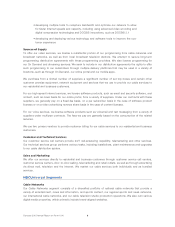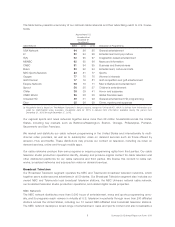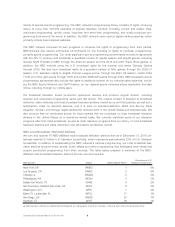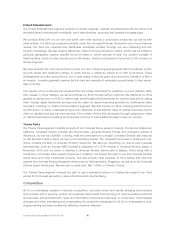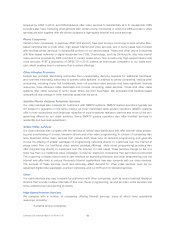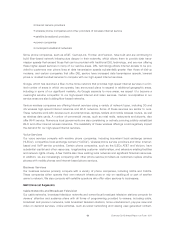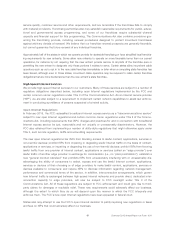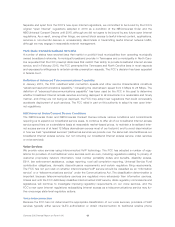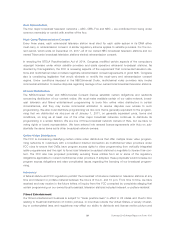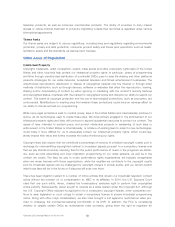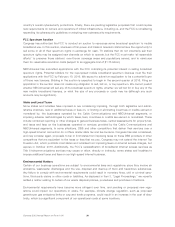Comcast 2015 Annual Report Download - page 19
Download and view the complete annual report
Please find page 19 of the 2015 Comcast annual report below. You can navigate through the pages in the report by either clicking on the pages listed below, or by using the keyword search tool below to find specific information within the annual report.agreement with the cable operator, which frequently will involve payments to the station. We currently pay
certain local broadcast television stations in exchange for their required consent for the retransmission of the
stations’ broadcast programming to our video services customers and expect to continue to be subject to
demands for increased payment and other concessions from local broadcast television stations. The FCC has
initiated a rulemaking to review aspects of these rules. For information on must-carry and retransmission
consent issues relating to our broadcast television business, see “NBCUniversal Segments — Broadcast
Television” below and refer to the “Must-Carry/Retransmission Consent” discussion within that section.
Pricing and Packaging
In 2015, the FCC revised its rate regulations to create a presumption that all local communities are subject to
effective competition and should no longer be subject to rate regulation that limits prices cable operators may
charge for basic video service, equipment and installation. That decision has been appealed in federal court.
The FCC accepted a certification from a Massachusetts franchising authority that demonstrated an absence
of effective competition in a number of the communities we serve in Massachusetts and that will allow for
continued rate regulation in those communities. All of the other areas we serve, except for a relatively small
number where we have a petition for effective competition still pending at the FCC, are covered by the FCC’s
presumption and are unregulated.
Cable Equipment
The Communications Act includes provisions aimed at promoting the retail availability of set-top boxes and
other equipment that can be used to receive digital video services. Prior to December 2015, multichannel
video providers were prohibited from deploying set-top boxes that performed both channel navigation and
security functions, so most of our set-top boxes relied on a separate security device known as a CableCARD.
Congress repealed this prohibition, so we may now deploy set-top boxes with integrated security. Congress
also directed the FCC to establish a working group to report on software-based security aimed at promoting
the retail availability of video devices. In the wake of that report, which was issued in August 2015, some
have proposed that the FCC replace the CableCARD requirements with new technology mandates on multi-
channel video providers to enable retail video devices to work on any multichannel video provider’s system.
The Chairman of the FCC proposed such a technology mandate in January 2016, and announced that the
FCC plans to open a rulemaking to consider the proposal. If implemented, this proposal would impose sub-
stantial costs on us, impair our ability to innovate and have other significant adverse effects on our business.
Pole Attachments
The FCC regulates the rates, terms and conditions that most pole-owning utility companies charge cable
operators and telecommunications carriers, including broadband Internet access service providers such as
us, for allowing attachments to their poles. States are permitted to preempt FCC jurisdiction and regulate the
rates, terms and conditions of attachments themselves, and many states in which we operate have done so.
Most of these states have generally followed the FCC’s pole attachment rate standards, which set rates for
telecommunications service pole attachments to levels at or near the rates for cable service attachments. In
November 2015, the FCC eliminated the ability of utility companies to justify higher rates for tele-
communication service pole attachments. Cable operators had requested this FCC action because the FCC’s
new open Internet regulations, as described below, reclassified Internet access service as a tele-
communications service, which could have allowed for higher rental rates to be applied to a majority of our
pole attachments. The FCC’s order ensuring that pole rates for telecommunications service attachments
approximate the cable service pole rate is expected to be challenged in court by the utility companies.
Franchising
Cable operators generally operate their cable systems under nonexclusive franchises granted by local or state
franchising authorities. While the terms and conditions of franchises vary materially from jurisdiction to juris-
diction, franchises typically last for a fixed term, obligate the franchisee to pay franchise fees and meet
Comcast 2015 Annual Report on Form 10-K 16


